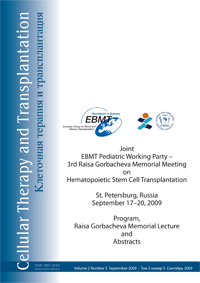The role of p53 polymorphisms in non–Hodgkin’s lymphomas’ susceptibility and prognosis
Elena N. Voropaeva, Tatiana I. Pospelova, Mikhail I. Voevoda, Olga V. Beresina
State Medical University, Scientific Research Institute of Therapy, The Russian Academy of Medical Sciences, Novosibirsk, Russia
Summary
Purpose
The purpose of our research was to estimate genotype distribution of p53 polymorphisms in NHL patients as well as the association of them with
non-Hodgkin’s lymphoma (NHL) risk and prognosis.
Patients and methods
Ninety-nine unrelated patients from the Novosibirsk City Hematological Center with different histological NHL entities were investigated. Genotyping was carried out with use of PCR and PCR-PLRF. The genotype and alleles distribution of Arg72Pro ex4, dup16bp in3 and G/C in6 gene p53 in patients were compared with the distribution in healthy, white Russian subjects from Novosibirsk and the Novosibirsk region.
Results
Statistically significant (P < 0.05) heterogeneity was observed between the patients with indolent and aggressive variants and different histological NHL entities. In addition, our data suggests that Pro-carrying genotypes of the p53 codon 72 (OR, 3.67; CI, 1.00–13.44; P < 0.05) and m-allele of the p53 in3 (OR, 5.56; CI, 2.25–13.7; P < 0.05) increased the risk of B non-small lymphocytic lymphoma, compared with population controls. At the same time, the patients with G-allele in6 gene p53 showed a significantly increased odds ratio (OR, 2.9; CI, 1.01–8.31; P < 0.05) of having B small lymphocytic lymphoma, compared with normal controls without G-allele. We further investigated the association of p53 polymorphisms with prognosis, according to the International Prognostic Index in NHL patients. Patients with an association of minor alleles in3, in6, and ex4 gene p53 tended to have poorer prognosis than those with normal homozygous genotype in these loci.
Conclusion
Our data suggested that Arg72Pro ex4, dup16bp in3, and G/C in6 gene p53 polymorphisms may play a role in NHL susceptibility and prognosis.
Keywords
polymorphism, p53, non-Hodgkin’s lymphoma, susceptibility


